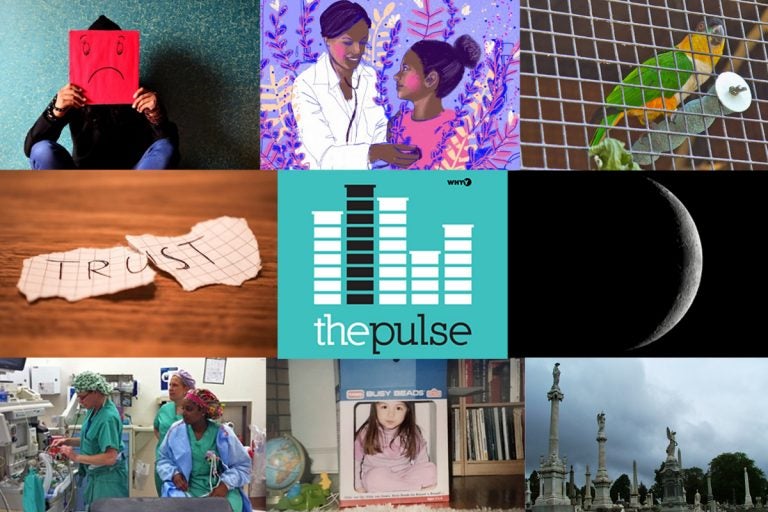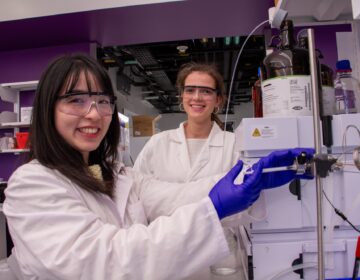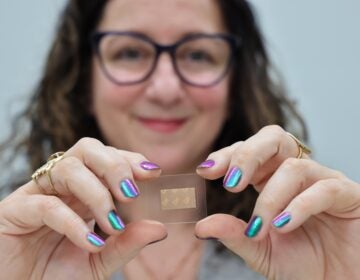The Pulse’s favorite episodes of the year
Here’s a list of some favorite episodes, curated by The Pulse team members themselves.

(Collage: The Pulse/WHYY)
As we approach the new year, and a new decade, we revisit some of The Pulse team’s favorite episodes of 2019.
Maiken Scott – Between Life and Death
Is there a space between life and death — a gray zone? It’s a question that has fascinated humans for thousands of years. I found myself being really drawn to this topic once we began researching it. We started the episode at one of my favorite Philadelphia places, Laurel Hill Cemetery, looking at the tomb of a famous Victorian-age medium who claimed she could talk to the dead. We explored how modern medicine blurs the lines between life and death, and spoke to an artist who is working with geneticists to bring back the scent of long-extinct flowers.
Alan Yu – The Other Side of the Moon
This episode is interesting because it took a different approach to a science story that every news outlet was covering, the 50th anniversary of the moon landing. The story about how the moon connects to rapid onset bipolar disorder is an excellent example of the scientific method at work: A researcher has a question, looks at the data, makes an unexpected connection that seems outlandish on the surface, welcomes skepticism, and arrives at a conclusion. All with a powerful personal story at the heart of it.
Jad Sleiman – The Changing Role of Nurses
This episode had my two favorite types of stories: the risky, into-the-unknown one, and the lay-expert one.
Liz Tung’s nurse-to-patient ratio story took a big risk. I don’t think there was a clear idea of what the final story would look like — there was just an interesting question, and she was off. Which I really like as a reporter. Those types of stories are really stressful to make on our time crunch, but I think they pay off because you end up with a truly novel exploration that really resonates with audiences — something new.
And I like the lay-expert school nurse one. It reminds me of a story from our episode, Marijuana Now, where a guy talked about his personal struggle with addiction to marijuana. I think the reason I really like these stories is that they have a baked-in authenticity that is very rare. They’re made by real people, who live in the world that we are talking about and work outside the media bubble. I think our audience can see themselves in these people. It’s a very unique thing to radio, its accessibility. We are able to help people who are not in the radio business tell their stories in a professional audio format.
Lindsay Lazarski – The Anatomy of Sadness
When we first conceived of an entire episode about sadness, my instinct was that the show could be a total bummer. But the more we dug into the emotion, the more I became fascinated by how our brain has the ability to trick us into feeling sad at strange moments, like after an intense workout.
One evening while producing the episode, I was sitting at my desk — with headphones on — editing an interview with neuroscientist Matt Sachs about how music can make us feel sad. When it came time to layer in the sad songs, I had to play Whitney Houston’s “I Will Always Love You” on repeat, to time it just right in the interview. My colleague Elizabeth Estrada, who sits next to me, peeked up from her desk, giving me the “What’s going on over there?” look. It turns out the volume on my headphones was way too loud. I swore to her, I was just playing that song over and over again for the show. At that point, we both burst out into laughter — and I nearly cried.
Liz Tung – Why We Play
At its best, journalism — and especially audio journalism — is a kind of living conversation between reporters and their audience. Which is why I love this episode — its genesis was a question from one of our listeners: What exactly is play, and why do we do it?
What I found most exciting about the episode’s premise was the way it defamiliarized an everyday topic. That was especially the case for me; in the course of developing this episode, I found out that I seemed to be the only member of our team who doesn’t play. That served as the launchpad for a piece exploring how (and whether) I could relearn how to play as an adult.
I also loved Alan Yu’s piece about which animals play and why. (Who would’ve guessed that spiders play?) Nina Feldman’s story about the impact of playgrounds, and the lack thereof, in lower-income neighborhoods was great as well. Throughout the episode, we heard from our listeners about what “play” means in their everyday lives. The episode was truly an exercise in discovering the extraordinary in the ordinary.
Steph Yin – In Science We Trust
Science doesn’t occur in a vacuum, it’s embedded in social, political and cultural contexts (think anti-vaccination, GMOs, climate change). But it can be hard to talk about all of that at once.
This episode does a great job of breaking down why public trust is crucial to doing science — and how that trust shouldn’t be taken for granted. I particularly loved Jad Sleiman’s piece about how discrimination, poor outreach, and a breakdown in community engagement ruined our chance of wiping out sickle cell disease back in the 1970s.
P.S. After I heard this episode on the radio, I applied to be a reporter with The Pulse (and got lucky!).
Xavier Lopez – Separate: Black Health in America
“Separate” was a great examination into some of the ways that experiences with health care are different for Black people in this country.
The interview with Nikole Hannah-Jones is fantastic. She explains how school segregation can make it harder for some Black people to break into STEM fields and how some seemingly non-consequential norms have dramatic effects for health care in America.
The story at the beginning of the episode, on the desegregation of health care, was a story that I didn’t know about. I had read and learned about the desegregation of schools and other institutions in high school and college, but segregation in health care wasn’t really mentioned. It wasn’t surprising, but it was interesting and upsetting to hear the uphill battle that some people in the health care system went through, to make sure that integration was followed in hospitals throughout the country.
WHYY is your source for fact-based, in-depth journalism and information. As a nonprofit organization, we rely on financial support from readers like you. Please give today.






